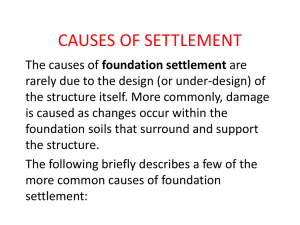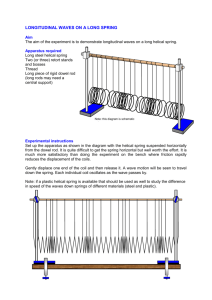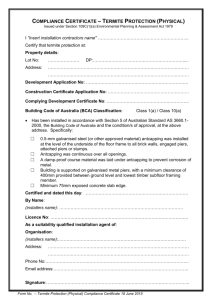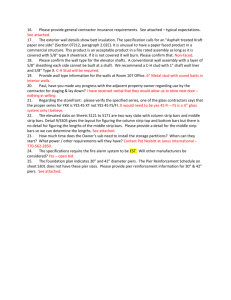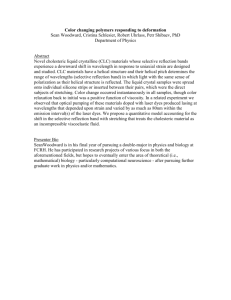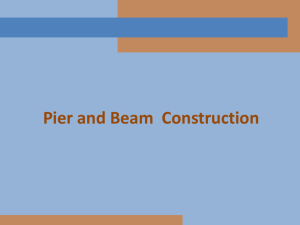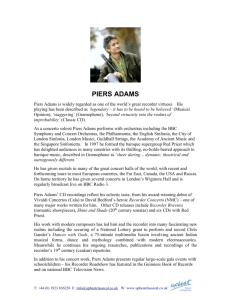Discussion on Underpinning
advertisement
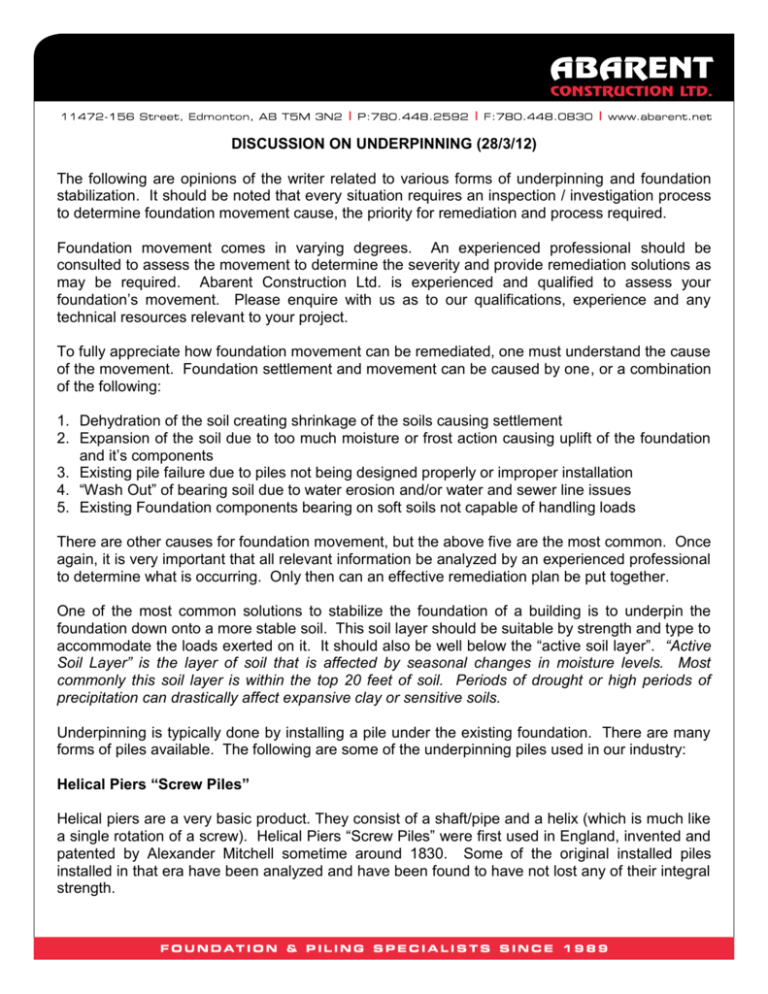
DISCUSSION ON UNDERPINNING (28/3/12) The following are opinions of the writer related to various forms of underpinning and foundation stabilization. It should be noted that every situation requires an inspection / investigation process to determine foundation movement cause, the priority for remediation and process required. Foundation movement comes in varying degrees. An experienced professional should be consulted to assess the movement to determine the severity and provide remediation solutions as may be required. Abarent Construction Ltd. is experienced and qualified to assess your foundation’s movement. Please enquire with us as to our qualifications, experience and any technical resources relevant to your project. To fully appreciate how foundation movement can be remediated, one must understand the cause of the movement. Foundation settlement and movement can be caused by one, or a combination of the following: 1. Dehydration of the soil creating shrinkage of the soils causing settlement 2. Expansion of the soil due to too much moisture or frost action causing uplift of the foundation and it’s components 3. Existing pile failure due to piles not being designed properly or improper installation 4. “Wash Out” of bearing soil due to water erosion and/or water and sewer line issues 5. Existing Foundation components bearing on soft soils not capable of handling loads There are other causes for foundation movement, but the above five are the most common. Once again, it is very important that all relevant information be analyzed by an experienced professional to determine what is occurring. Only then can an effective remediation plan be put together. One of the most common solutions to stabilize the foundation of a building is to underpin the foundation down onto a more stable soil. This soil layer should be suitable by strength and type to accommodate the loads exerted on it. It should also be well below the “active soil layer”. “Active Soil Layer” is the layer of soil that is affected by seasonal changes in moisture levels. Most commonly this soil layer is within the top 20 feet of soil. Periods of drought or high periods of precipitation can drastically affect expansive clay or sensitive soils. Underpinning is typically done by installing a pile under the existing foundation. There are many forms of piles available. The following are some of the underpinning piles used in our industry: Helical Piers “Screw Piles” Helical piers are a very basic product. They consist of a shaft/pipe and a helix (which is much like a single rotation of a screw). Helical Piers “Screw Piles” were first used in England, invented and patented by Alexander Mitchell sometime around 1830. Some of the original installed piles installed in that era have been analyzed and have been found to have not lost any of their integral strength. “Screw Piles” are installed at relatively low RPM with an increase in torque during installation. Sections are added as the pier is screwed into the ground. Once the predetermined depth and installation torques are reached the pile can be cut off and a load bearing plate or bracket is attached. When underpinning, this bracket can also be used to accommodate lifting the foundation to level building elements. The latter is a definite advantage over some of the underpinning systems available. Installation of the piles can be done with anything from small portable equipment to varying sizes of machinery such as a backhoe or skid steer. During the installation of helical screw piles, crews will record the pressure on the hydraulic motor and with that, the torque can be calculated. This installation torque has been shown to have direct Why Helical Piers? correlations to installed pile capacity. A reputable company will only use this installation torque as a confirmation to an already engineered pile design based on a soils investigation. omparison of alternative foundation supports Aside from little to no vibration and very little soil disturbance being a definite advantage of Helical Screw Piles, these piles also resist upward forces. This is especially important in expansive simple answer is price andhelix performance. In many cases helical piers are the easiest to install soil. The is anchored in competent load bearing soil and and the frictional forces along the shaft eads to lower cost. They also have the most predicable load carrying capacity. However, this is not are negligible compared to the end bearing force. On that note, the biggest advantage of Helical ys the case. Discussing these exceptions is the purpose of this article. Screw Piles has to be the fact that they are designed as a “True End Bearing Pile” only. Any article is aimed at installers andfriction” designers who are unfamiliar andisare trying to minimal “skin on the side ofwith thehelical pile piers shaft not calculated into the piles required capacity. cate themselves to this increasingly popular form of foundation support. To do this, I will discuss the The amount of weight the pile can handle is governed by the bottom of the pile (Helix plate). This ngth and weaknesses of all the varieties of foundation support. Then I will summarize them in a table creates in the Helical System to perform ase of comparison. Theconfidence methods can roughly be divided intoPier light and heavy structure supports.in soils where moisture levels change (which would change the parameters upon which any friction pile would work). Keeping in mind Light to moderate supports that the structure most common reason for foundation settlement is shrinkage of the soils due to moisture loss, the Helical Pier is the most practical choice for the Engineering community. Collins, P.E. ical Piers are different manufacturers of Helical and they are not all equal. Connection stiffness cal piers can There be used almost anywhere traditional deep foundations can be Piers used according to Don bitt PE, an experienced helical pier engineer.[1] are better suited to the lower capacity is of great importance asTypically, is pilethey design and stringent adherence to the manufacturing process. ications that make it less economical to use the larger install equipment required by the more Our manufacturing company, Helical Pier Systems (HPS), ventional deep foundations. They also tend to be more economical in limited access sites or for dedicates considerable resources to ation or noisetheir free applications. economics of each process. case generally controls researchHowever, and the manufacturing HPS the has offered engineering, manufacturing, dation selection. equipment design, creation and distribution for helical piling products since 1977. cal piers are installed screw them into the d mounted on anything ll spaces up to large where one has a torque driver machine that ground. Usually this is a hydraulic torque from a portable torque frame that can fit into backhoe mounted devices. cal piers screw y into bedrock. The er torque. This is recorded by the ughly 10 times the oking for a significant se, firm load-bearing age 20 to 30 feet below themselves through the many layers and layers are usually revealed by the varying monitored by a torque pressure gauge read machine operator. The pier bearing capacity “kips” indicated on the gauge. The operator increase in torque indicating he has hit strata. For many locations, this is on grade. ions are added as the pier is screwed into the ground. The final on is cut off at a level even with the other piers and capped with a -bearing plate. It is immediately ready to receive a load. There o cleanup. This process is quick if everything goes as planned and is atter of hours for a multiple pier job. If difficult soil is ountered and pre-drilling is necessary to break into hard rock, it can a matter of several days. A very good comparison with tional drilled piers can be found at the Helical Pier World’s http://helicalpierworld.com/articles/taleof2part2.aspx. This running account of two side-by-side jobs aks volumes about many factors in pier installation. An advantage of helical piers in expansive soil is th forces. The helix is anchored in competent load-be and the frictional forces along the shaft are negligib end loading force. This means the helical pier is ve upward or downward loads. This is not the case wi support without secondary operations or modificatio with grout. There are different manufacturers of helical piers, a equal. Connection stiffness is an issue. It needs to since a weak joint under compressive forces will bu installation techniques to stiffen the connections an on Helical Pull-Down Micropiles), but it is better to u connections to begin with. One advantage of helical piers is that if a rock is en forward progress, the pier can be withdrawn and dri away. Don Bobbit has also written a very comprehe many difficulties and non-technical factors involved installation and use of helical piers. [2] Hydraulic push piers Hydraulic push piers are essentially a helical pier These are steel rods driven down into the ground which is pushing up against the foundation. To w with grout. There are different manufacturers of helical piers, and they are not all equal. Connection stiffness is an issue. It needs to be paid attention to since a weak joint under compressive forces will buckle. There are post installation techniques to stiffen the connections and shafts (see section on Helical Pull-Down Micropiles), but it is better to use piers that have stiff connections to begin with. An advantage of helical piers in expansive soil is that they resist u One advantage of helical piers is forces. that if a rock encountered that stops Theishelix is anchored in competent load-bearing soil or be Hydraulic Push Piers forward progress, the pier can be withdrawn and drilled several feet and the frictional forces along the shaft are negligible compared to away. Don Bobbit has also written a very comprehensive paper on the end loading force. This means helical pier is versatile manyare difficulties and non-technical factors involved in successful Hydraulic Push Piers steel pipe or rods driven down into the ground bythe a hydraulic jack which with eit upward or downward loads. This is not the case with other types installation and use of helical piers. [2] be careful that the foundation that it is pushing is pushing up against the foundation. One must support without secondary operations or modifications such as fill piers with grout. against is strong enough to take the concentrated load. Hydraulic push As each pier is driven, the friction between the soil and the pier accumulates until it exceeds the Therea are different manufacturers of helical piers, and they are no Hydraulic pushAt piers essentially helical pierstarts without load being placed on the pier. thisare point the foundation tothe lifthelix. and the pier refuses to go equal. Connection an issue. It needs to be paid atten These are steel rods driven down into the ground by stiffness a hydraulicisjack any deeper with the available foundation weight. This is one of the disadvantages of this type which is pushing up against thesince foundation. work, therecompressive needs to be forces will buckle. There a a weakTojoint under of system, as on a something lot of occasions one should go are past soft layer just underneath a hard layer to to push against, so installation these notatechniques suitable for new to stiffen the connections and shafts (see s more competent soils. Another disadvantage of the Hydraulic Push Pierbutisitthat since theypiers that h construction where the foundation has not Pull-Down yet been poured. However on Helical Micropiles), is better to use they are suitable for remedial foundation lifting wherecan the lift them. Further to are friction supported, expansive clay in work the and intermediate layers connections to begin with. typical weight of the structure is in the neighborhood of one ton per that, the main disadvantage is that the soil friction along the side of the pier can change it’s lineal foot. However, one must be careful that the foundation that it is characteristics creating a situation where it’s to handle weights In is contrast, Oneaability advantage helical piers ischanges. that if a rock encountered tha attached to is strong and can take concentratedofload. Helical Piers are end loaded, are not affected by a light foundation, and are unaffected byseveral fe forward progress, the pier can be withdrawn and drilled intermediate expansive soils. away. Donso Bobbit also weight writtenisa very comprehensive paper o The piers are typically driven one at a time the fullhas building available to drive the pier. As each is driven, and the friction between factors involved in successful manypier difficulties non-technical the to soilbe andcareful the pier when accumulates until it exceeds the load being this placed The consumer needs hiring contractors that system as often the installation and use of utilize helical piers. [2] pier. pipe This isand called “driving refusal” the foundation pipe being installedonisthe used there is to very littlewhere testing or qualityjustcontrol with the pile starts to lift and the pier refuses to go any deeper with the available components. foundation weight. Hydraulic push piers An advantage over helicals is that they can be installed without any Hydraulic torque push piers are essentially a helical pier without the he equipment, generally closer to a wall, and can register the load capacity These are steel rods driven down into the ground by a hydrauli directly. The disadvantage is that since they are friction supported, which expansive clay in the intermediate layers can lift them up unless they are is pushing up against the foundation. To work, there nee something to push against, so these are not suitable for new deep enough into bedrock or other layers unaffected by moisture. This construction where the foundation has not yet been poured. Ho means that they must have enough force on them to drive them to bedrock, something that is not always done if the contractor is in a hurry or they are suitable for remedial work and foundation lifting where careless. Refusal should happen at bedrock but won’t if there is nottypical weight of the structure is in the neighborhood of one ton enough reaction force from a lightly loaded foundation. In contrast, lineal helical foot. However, one must be careful that the foundation th piers are end loaded, are not affected by a light foundation, and are attached to is strong and can take a concentrated load. generally unaffected by intermediate expansive soil. The piers are typically driven one at a time so the full building w available to drive the pier. As each pier is driven, the friction be the soil and the pier accumulates until it exceeds the load being on the pier. This is called “driving to refusal” where the foundat starts to lift and the pier refuses to go any deeper with the avail foundation weight. An advantage over helicals is that they can be installed without any torque equipment, generally closer Shaft) to a wall, and can register the load capacity Concrete Drilled Pile Caissons (Drilled directly. The disadvantage is that since they are friction supported, in the intermediate layers can lift them up are concrete and A drilled pier isexpansive a deep clay foundation system that is constructed by unless placingthey fresh into bedrock or other layers unaffected moisture. This it with a rebar reinforcing steeldeep in a enough drilled shaft. This pile is installed by drilling by a hole, reinforcing means that they must have enough force on them to drive them to bedrock, cage dropped down the hole, and then pouring in concrete. For Underpinning, the work area is something that is not always done if the contractor is in a hurry or careless. Refusal should happen at bedrock but won’t if there is not enough reaction force from a lightly loaded foundation. In contrast, helical piers are end loaded, are not affected by a light foundation, and are generally unaffected by intermediate expansive soil. tight, so the most common method of drilling this hole is with a fabricated A-Frame that leans against the structure and hydraulically drills the hole with an auger. There are a multitude of disadvantages to this type of pile system. (1) It is very difficult to attain depths over 25 feet deep due to drilling constraints. This is often necessary to accommodate the soil issues that are the reason for being there in the first place. (2) The drilled concrete pile relies on soil friction along the side of the pile to provide capacity. As discussed earlier, this is a definite problem as the most common reason for Underpinning is due to changes in soil moisture content. These changes alter the soils ability to provide friction along the concrete pile. It is quite common to see failure of this type of pile due to that reason. (3) The pile system does not generally allow for any lifting mechanism, so in most cases is just used to attempt stabilization of the foundation. (See Engineering Paper Helical Piers vs. Drilled Concrete Piers in Highly Expansive Soil Areas by Ryan J. Hardesty, P.E. for a case study on this pile type– Attached to this handout – Much of the same principals discussed and illustrated in this paper can be used in reference to Hydraulic Push Piers) Expanding Foam Resin: There is a proprietary process used by a company where a foam resin is injected into the soil below the footing area. This foam is theoretically used to “stabilize and lift” the footing and foundation. It is our opinion that any lift would not be possible without a mechanically method of lifting (hydraulics etc.). Considering that the main reason for foundation settlement is dehydration of expansive clay it is illogical to agree that injection and densifying of the soil at this level will prevent any further settlement if expansive clays continue to dehydrate and shrink. If the main issue were weak base soils or an issue with granular soils or permafrost there might be a positive argument to using this method. We have personally seen too many failures with this method used for foundation stabilization or “lifting” to endorse it. Years ago Abarent Construction Ltd spent considerable time researching which piling system it should use for Underpinning. Obviously we could have picked any of the methods available, but chose to endorse the method that was most viable for our climate and soil type…The Helical Screw Pile. We have evolved a process for all Underpinning Projects: 1. Engineered Design of the project that includes: For Underpinning - Analyze pattern of cracking and location of cracks Calculate loads of structure and point load areas Calculate allowable spans between piles (This varies on foundation type and size) Obtain soils data from a Soils Bore Hole Have our Manufacturer (HPS) design the pile based on required Loads and Soils Data Provide an Engineered Stamped Plan for the project 2. Obtain a Building Permit 3. Excavate and Prep Pile locations 4. Install piles and record installation pressures (Torques) 5. For Underpinning – Install Patented Underpinning Brackets 6. For Underpinning – Lift Structure (as structure allows) to as close to level as possible 7. Backfill and clean-up project 8. Provide all installation Data to Engineer 9. Obtain Pile Certification from Engineer **No part of this handout shall be used in any form without the express written permission of Abarent Construction Ltd. Copyright 2012**
